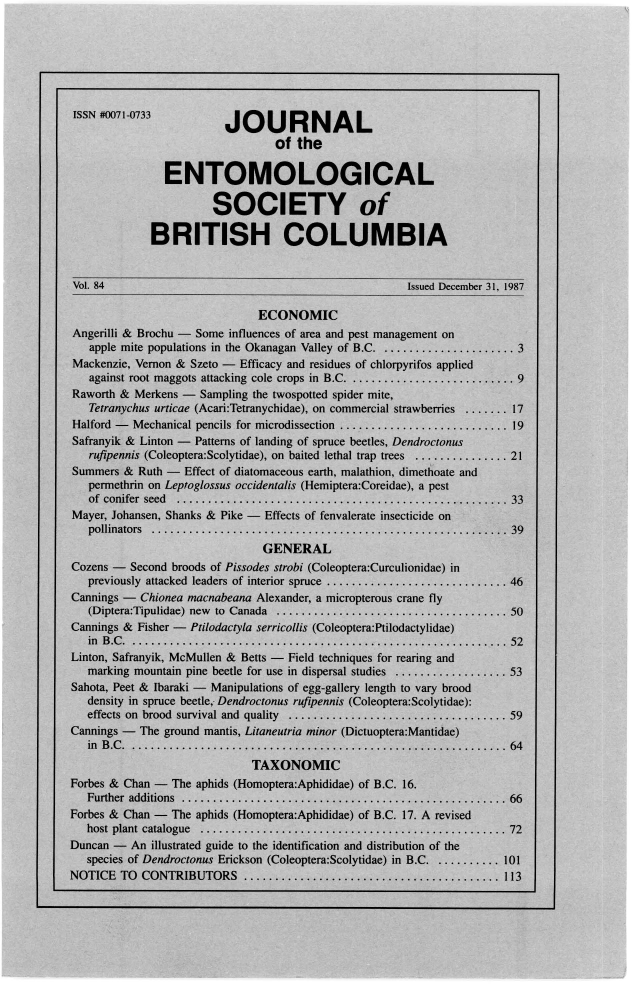Effect of diatomaceous earth, malathion, dimethoate and permethrin on <i>Leploglossus occidentalis</i> (Hemiptera: Coreidae), a pest of conifer seed
Keywords:
<i>Leploglossus occidentalis</i>, Hemiptera, CoreidaeAbstract
<i>Leptoglossus occidentalis</i> Heidemann (Hemiptera: Coreidae) were exposed to diatomaceous earth, and sprays of dimethoate (0.1 and 1.0% a.i.) and permethrin (0.1% and 0.01% a.i.) in both laboratory and field tests and to malathion (0.1% a.i.) in a laboratory test. In field tests, permethrin and dimethoate caused significant (P < .05) mortality for two weeks after the sprays were applied and permethrin continued to be effective for a third week. Diatomaceous earth was not effective in field tests or in one of two laboratory tests. Malathion, dimethoate and permethrin caused significant mortality in both laboratory tests.
References
Bradley, E.L., B.H. Ebel, and K.O. Summerville. 1981. Leptoglossus spp. observed on Eastern White Pine and Fraser Fir Cones. USDA For. Serv. Res. Note SE-310.
DeBarr, G.L. 1978. Southwide Tests of Carbofuran for Seedbug Control in Pine Seed Orchards. USDA For. Serv. Res. Pap. SE-185.
DeBarr, G.L. 1979. Importance of the seedbugs Leptoglossus corculus (Say) (Hemiptera:Coreidae) and Tetyra bipunctata (H.-S.) (Hemiptera: Pentatomidae) and their control in southern pine seed orchards. In: F. Bonner (ed.). Proceedings: A Symposium on Flowering and Seed Development in Trees. Mississippi State University, May 15-18, 1978. I.U.F.R.0. 380 pp.
DeBarr, G.L. and J.C. Nord. 1978. Contact Toxicity of 34 Insecticides to Second-Stage Nymphs of Leptoglossus corculus (Hemiptera: Coreidae). Can. Entomol. 110:901-906.
Environment Canada. 1986. Weather Record. Times Colonist. Victoria, B.C. Canada. Sept. 5-25, 1986.
Fleiss, J.L. 1981. Statistical Methods for Rates and Proportions. John Wiley and Sons. N.Y. 321 pp.
Hedlin, A.F., H.O. Yates II, D.C. Tovar, B.H. Ebel, T.W. Koerber, and E.P. Merkel. 1980. Cone and Seed Insects of North American Conifers. Can. For. Serv./USDA For. Serv./Secr. Agric. Recur. Hidraul., Mexico, Victoria, B.C. 122 pp.
Koerber, T.W. 1963. Leptoglossus occidentalis (Hemiptera:Coreidae), a newly discovered pest of coniferous seed. Ann. Ent. Soc. Amer. 56:229-234.
Miller, G.E. 1980. Pest Management in Douglas-fir Seed Orchards in British Columbia: A Problem Analysis. Pest Management Papers No. 22, April 1980. Simon Fraser University, Burnaby, B.C., Canada.
Nord, J.C., G.L. DeBarr, N.A. Overgaard, W.W. Neel, R.S. Cameron, and J.F. Godbee. 1984. High-volume Applications of Azinphosmethyl, Fenvalerate, Permethrin, and Phosmet for Control of Coneworms (Lepidoptera: Pyralidae) and Seed Bugs (Hemiptera: Coreidae and Pentatomidae) in Southern Pine Seed Orchards. J. Econ. Entomol. 77:1589-1595.
Nord, J.C., G.L. DeBarr, L.R. Barber, J.C. Weatherby, and N.A. Overgaard. 1985. Low-volume applications of azinphosmethyl, fenvalerate and permethrin for control of coneworms (Lepidoptera: Pyralidae) and seed bugs (Hemiptera: Coreidae and Pentatomidae) In southern pine seed orchards. J. Econ. Entomol. 78:445-450.
Ross, T.E. 1981. Diatomaceous Earth as a Possible Alternative to Chemical Insecticides. Agric. and Environ. 6:43-51.
Ruth, D.S. 1980. A Guide to Pests in Douglas-fir Seed Orchards. Environ. Can. C.F.S. BC-X-204.
Downloads
Published
Issue
Section
License
Authors who publish with the Journal of the Entomological Society of British Columbia agree to the following terms:
-Authors retain copyright and grant the journal right of first publication with the work simultaneously licensed under a Creative Commons Attribution License that allows others to share the work with an acknowledgement of the work's authorship and initial publication in this journal.
-Authors are able to enter into separate, additional contractual arrangements for the non-exclusive distribution of the journal's published version of the work (e.g., post it to an institutional repository or publish it in a book), with an acknowledgement of its initial publication in this journal.
-Authors are permitted and encouraged to post their work online (e.g., in institutional repositories or on their website) prior to and during the submission process, as it can lead to productive exchanges, as well as earlier and greater citation of published work (See The Effect of Open Access).


